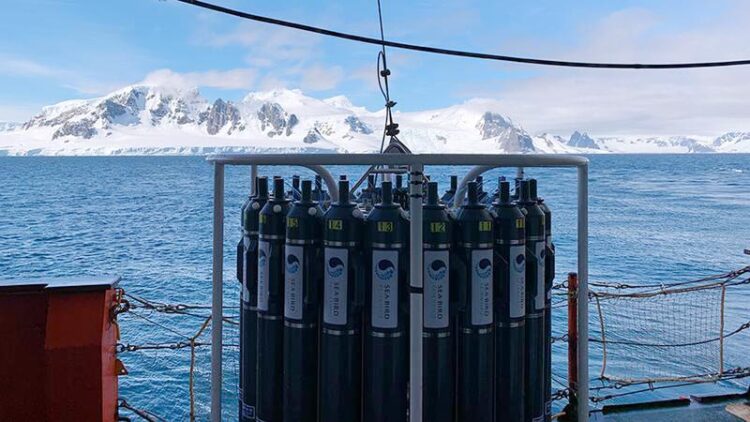Ocean ecosystem: Mixotrophic microorganisms play key role

Hunting for microbes in the global ocean. Sampling of seawater is performed with Niskin Bottles, which are cylindrical container used in oceanography to collect water samples containing microbes at various depths, triggered to snap shut at the desired depth.
Credit: © 2022 Federico Baltar
Previously unknown group of bacteria in the deep sea regulates energy balance.
A team of international researchers led by Federico Baltar of the University of Vienna and José M González of the University of La Laguna has identified a previously unknown group of bacteria, called UBA868, as key players in the energy cycle of the deep ocean. They are significantly involved in the biogeochemical cycle in the marine layer between 200 and 1000 meters. The results have now been published in the journal Nature Microbiology.
The deep sea, the marine layer at depths of 200 meters and more, accounts for about 90 percent of the world’s ocean volume. It forms the largest habitat on Earth and is home to the largest number of microorganisms. These microorganisms contribute significantly to the biogeochemical cycles. They extract organic material, for example from phytoplankton and zooplankton, transform it and make it available again to the ecosystem as nutrients. In this way, they play a major role in the fixation and cycling of carbon. Dissolved sulfur compounds are also converted by bacteria and returned to the material cycle.
UBA868: mixotrophic energy driving force in ecosystems
UBA868 plays a significant role in the oxidation of sulfur compounds and the fixation of carbon dioxide, thus contributing significantly to the energy balance in the deep sea. “Interestingly, UBA868 is mixotrophic. This means that it can both fix carbon from CO2 using the energy generated by oxidizing sulfur compounds and take up organic substances and use them for energy production” explains Federico Baltar. This finding refutes the previously held assumption that only autotrophic microorganisms (that can use CO2 as a carbon source) and heterotrophic microorganisms (that rely on organic carbon sources) are responsible for regulating the carbon cycle.
To investigate the role of UBA868 in the ocean, the team used a combination of genomic analysis methods, including single-cell genomics, community metagenomics, metatranscriptomics and single-cell activity measurements. Finally, analysis of gene libraries from multiple, worldwide expeditions confirmed the ubiquitous distribution and global importance of this bacterial group. This discovery contributes to our understanding of marine ecosystems and the ocean’s ability to store carbon. At the same time, it shows how important it is to also put mixotrophic bacteria in the focus of research on the cycling of nutrients in the ocean.
Journal: Nature Microbiology
DOI: 10.1038/s41564-023-01374-2
Article Title: A ubiquitous gammaproteobacterial clade dominates expression of sulfur oxidation genes across the mesopelagic ocean
Article Publication Date: 24-Apr-2023
Media Contact
Veronika Schallhart
University of Vienna
presse@univie.ac.at
Office: +43-1-4277-175 30
Original Source
Media Contact
All latest news from the category: Ecology, The Environment and Conservation
This complex theme deals primarily with interactions between organisms and the environmental factors that impact them, but to a greater extent between individual inanimate environmental factors.
innovations-report offers informative reports and articles on topics such as climate protection, landscape conservation, ecological systems, wildlife and nature parks and ecosystem efficiency and balance.
Newest articles

Largest magnetic anisotropy of a molecule measured at BESSY II
At the Berlin synchrotron radiation source BESSY II, the largest magnetic anisotropy of a single molecule ever measured experimentally has been determined. The larger this anisotropy is, the better a…

Breaking boundaries: Researchers isolate quantum coherence in classical light systems
LSU quantum researchers uncover hidden quantum behaviors within classical light, which could make quantum technologies robust. Understanding the boundary between classical and quantum physics has long been a central question…

MRI-first strategy for prostate cancer detection proves to be safe
Active monitoring is a sufficiently safe option when prostate MRI findings are negative. There are several strategies for the early detection of prostate cancer. The first step is often a…



